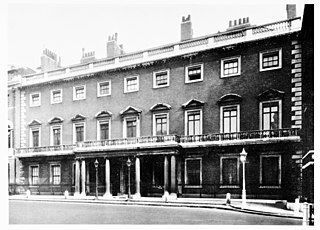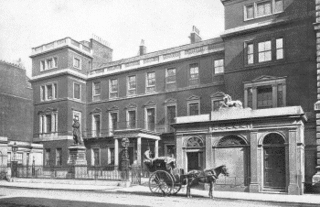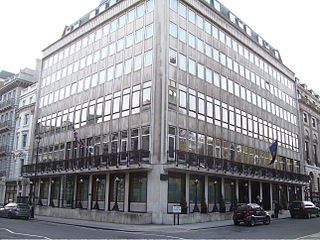
Georgian architecture is the name given in most English-speaking countries to the set of architectural styles current between 1714 and 1830. It is named after the first four British monarchs of the House of Hanover, George I, George II, George III, and George IV, who reigned in continuous succession from August 1714 to June 1830.

The West End of London is a district of Central London, London, England, west of the City of London and north of the River Thames, in which many of the city's major tourist attractions, shops, businesses, government buildings and entertainment venues, including West End theatres, are concentrated.

Marlborough House, a Grade I listed mansion on The Mall in St James's, City of Westminster, London, is the headquarters of the Commonwealth of Nations and the seat of the Commonwealth Secretariat. It is adjacent to St James's Palace.

Wardour Street is a street in Soho, City of Westminster, London. It is a one-way street that runs north from Leicester Square, through Chinatown, across Shaftesbury Avenue to Oxford Street. Throughout the 20th century the West End street became a centre for the British film industry and the popular music scene.

Belgravia is a district in Central London, covering parts of the areas of the City of Westminster and the Royal Borough of Kensington and Chelsea.

Pall Mall is a street in the St James's area of the City of Westminster, Central London. It connects St James's Street to Trafalgar Square and is a section of the regional A4 road. The street's name is derived from pall-mall, a ball game played there during the 17th century, which in turn is derived from the Italian pallamaglio, literally "ball-mallet".

St James's is a central district in the City of Westminster, London, forming part of the West End. The area was once part of the northwestern gardens and parks of St. James's Palace. During the Restoration in the 17th century, the area was developed as a residential location for the British aristocracy, and around the 19th century was the focus of the development of their gentlemen's clubs. Once part of the parish of St Martin in the Fields, much of it formed the parish of St James from 1685 to 1922. Since the Second World War the area has transitioned from residential to commercial use.

Almack's was the name of a number of establishments and social clubs in London between the 18th and 20th centuries. Two of the social clubs would go on to fame as Brooks's and Boodle's. Almack's most famous establishment was based in assembly rooms on King Street, St James's, and was one of a limited number of upper-class mixed-sex public social venues in the British capital in an era when the most important venues for the hectic social season were the grand houses of the aristocracy. The site of the club, Almack's Assembly Rooms or Willis's Rooms, has become retrospectively interchangeable with the club, though for much of the club's lifetime, the rooms offered a variety of other entertainments with no connection to the club.

Carlton House Terrace is a street in the St James's district of the City of Westminster in London. Its principal architectural feature is a pair of terraces, the Western and Eastern terraces, of white stucco-faced houses on the south side of the street, which overlook The Mall and St. James's Park. These terraces were built on Crown land between 1827 and 1832 to overall designs by John Nash, but with detailed input by other architects including Decimus Burton. Construction was overseen by James Pennethorne. Both terrace blocks are Grade I listed buildings. A separate but linked cul de sac at the terrrace's western end is named Carlton Gardens.

Norfolk House was the London residence of the Dukes of Norfolk, and as such more than one building has been given this name. The first was opposite Lambeth Palace, set in acres of garden and orchards on a site occupying what is now the Novotel London Waterloo on Lambeth Road.

Cumberland House was a mansion on the south side of Pall Mall in London, England. It was built in the 1760s by Matthew Brettingham for Prince Edward, Duke of York and Albany and was originally called York House. The Duke of York died in 1767 aged just twenty eight and the house was taken over by Prince Henry, Duke of Cumberland and Strathearn, whose name it has retained.

Schomberg House at 80–82 Pall Mall is a prominent house on the south side of Pall Mall in central London which has a colourful history. Only the street facade survives today. It was built for The 3rd Duke of Schomberg, a Huguenot general in the service of the British Crown. It was adapted from Portland House, which in turn had been created by the Countess of Portland by converting two houses into a single residence. Work began in 1694, the year after the duke inherited his title.

St James's Street is the principal street in the district of St James's, central London. It runs from Piccadilly downhill to St James's Palace and Pall Mall. The main gatehouse of the Palace is at the southern end of the road; in the 17th century, Clarendon House faced down the street across Piccadilly from the site of what is now Albemarle Street.

Matthew Brettingham, sometimes called Matthew Brettingham the Elder, was an 18th-century Englishman who rose from modest origins to supervise the construction of Holkham Hall, and become one of the best-known architects of his generation. Much of his principal work has since been demolished, particularly his work in London, where he revolutionised the design of the grand townhouse. As a result, he is often overlooked today, remembered principally for his Palladian remodelling of numerous country houses, many of them situated in the East Anglia area of Britain. As Brettingham neared the pinnacle of his career, Palladianism began to fall out of fashion and neoclassicism was introduced, championed by the young Robert Adam.

The Pall Mall Restaurant was a hostelry situated at Number 1 Cockspur Street, Westminster, London, just off Pall Mall and near Trafalgar Square. The site was subsequently the offices of the White Star Line, and was then occupied by a Tex Mex restaurant, the Texas Embassy Cantina. Currently the site is unused.

The St James's Club was a London gentlemen's club which operated between 1857 and 1978. It was founded by two leading diplomats and its members continued to be largely diplomats and authors. It was first established in Charles Street and moved to 106 Piccadilly by 1868. In the final quarter of the twentieth century many gentlemen’s clubs of London suffered from declining membership, and in 1978 the St James's Club merged with Brooks's Club and vacated its premises.

The Army and Navy Club in London is a private members club founded in 1837, also known informally as The Rag.
Robert Furze Brettingham (1750–1820) was an English architect, the nephew of Matthew Brettingham the Elder, who practised in London.

St James's Place is a street in the St James's district of London near Green Park. It was first developed around 1694, the historian John Strype describing it in 1720 as a "good Street ... which receiveth a fresh Air out of the Park; the Houses are well-built, and inhabited by Gentry ..." Henry Benjamin Wheatley wrote in 1870 that it was "one of the oddest built streets in London."

In British usage, the term townhouse originally referred to the opulent town or city residence of a member of the nobility or gentry, as opposed to their country seat, generally known as a country house or, colloquially, for the larger ones, stately home. The grandest of the London townhouses were stand-alone buildings, but many were terraced buildings.


























